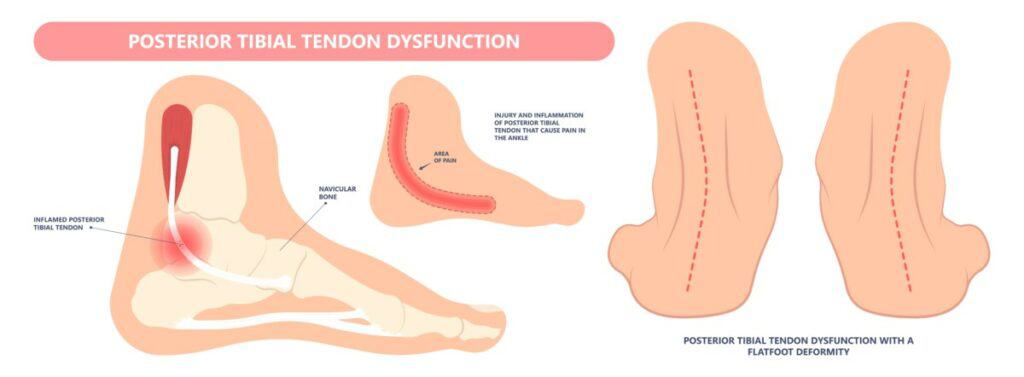Adult-Acquired Flat Foot (ADFD)
- Best Asics Shoes for Flat Feet - October 25, 2024
- Best Running Shoes for Flat Feet - October 22, 2024
- Posterior Tibial Tendonitis - October 21, 2024
What is Adult Acquired Flat Foot (AAFD)?
Adult Acquired Flat Foot (AAFD) is a condition that occurs when the natural arch of the foot collapses, often due to the weakening of the supporting structures, such as the Posterior Tibial Tendon. This tendon stabilises the medial side of the ankle and supports the foot’s arch. When the tendon becomes stretched, elongated, or weakened, it can lead to a gradual flattening of the foot, resulting in an Adult Acquired Flat Foot.

Symptoms of AAFD
In the early stages of Adult Acquired Flat Foot, there is often pain on the inside of the ankle, especially with activities that involve impact, such as walking, running, or jumping. Other common symptoms include:
- Pain that is typically worse first thing in the morning.
- Minimal swelling or bruising around the inner ankle.
- A gradual reduction in the height of the foot’s arch.
- Visible signs include the “too many toes” sign, which indicates that more toes are visible from behind due to the foot’s outward rotation.
As the condition worsens, pain may spread to both the inner and outer ankle, and in severe cases, the foot’s arch may collapse entirely, leading to difficulty with walking and standing.
Causes of AAFD
The most common cause of Adult Acquired Flat Foot is the weakening or dysfunction of the Posterior Tibial Tendon. Some of the key risk factors include:
- Age: AAFD is more common in middle-aged adults as the tendon naturally weakens over time.
- Repetitive injuries: Frequent ankle sprains or a history of ankle fractures can contribute to tendon damage.
- Obesity: Excess body weight puts additional strain on the Posterior Tibial Tendon, increasing the risk of dysfunction.
Diagnosing AAFD
Diagnosing Adult Acquired Flat Foot involves a clinical assessment by a healthcare professional such as a Physical Therapist. Key diagnostic markers include:
- A noticeable reduction in the foot’s arch height.
- The “too many toes” sign when observing the foot from behind.
- Difficulty or inability to perform a single leg heel raise, where the heel should lift, and the calcaneus should invert.
Imaging tests may also be used:
- MRI is often preferred as it can show inflammation, swelling, and damage to the tendon or surrounding structures.
- X-rays may be recommended to assess for arthritis or other structural changes, particularly in more advanced cases.
Treatment
Treatment typically begins with non-surgical options designed to strengthen the foot, reduce pain, and improve function. Common treatments include:
- Physical Therapy: Strengthening exercises focused on the Soleus muscle, Posterior Tibial Tendon, and intrinsic foot muscles can effectively alleviate symptoms and prevent further deterioration in the condition’s early stages.
- Footwear and Insoles: Wearing supportive footwear is essential, and custom orthotics can help provide additional arch support and reduce strain on the tendon. Insoles designed to control overpronation can be particularly beneficial for patients with AAFD.
- Bracing: For more severe cases, a Posterior Tibial Tendon Brace can offer additional stability and reduce pain while allowing the patient to continue their daily activities.
- Activity Modification: Non-impact exercises like swimming or cycling are recommended to maintain fitness without placing excessive stress on the affected tendon.
When to Consider Surgery
In advanced stages of Adult-Acquired Flat Foot (Stage 2b onwards), where there is significant arthritis or deformity, surgery may be required to correct the condition. Depending on the severity of the condition, surgical options may include tendon repair, bone realignment, or joint fusion.
Avoiding Steroid Injections
While steroid injections can reduce inflammation and pain, they are generally not recommended for Adult-Acquired Flat Feet because they can weaken the tendon further and reduce its ability to handle physical load.
Final Thoughts
Adult-acquired flat Foot is a progressive condition that can lead to significant discomfort if not properly managed. Early diagnosis and treatment with physical therapy, supportive footwear, and custom orthotics can help control symptoms and slow the condition’s progression. If you’re experiencing symptoms, it’s important to seek advice from a specialist to ensure the best treatment.
